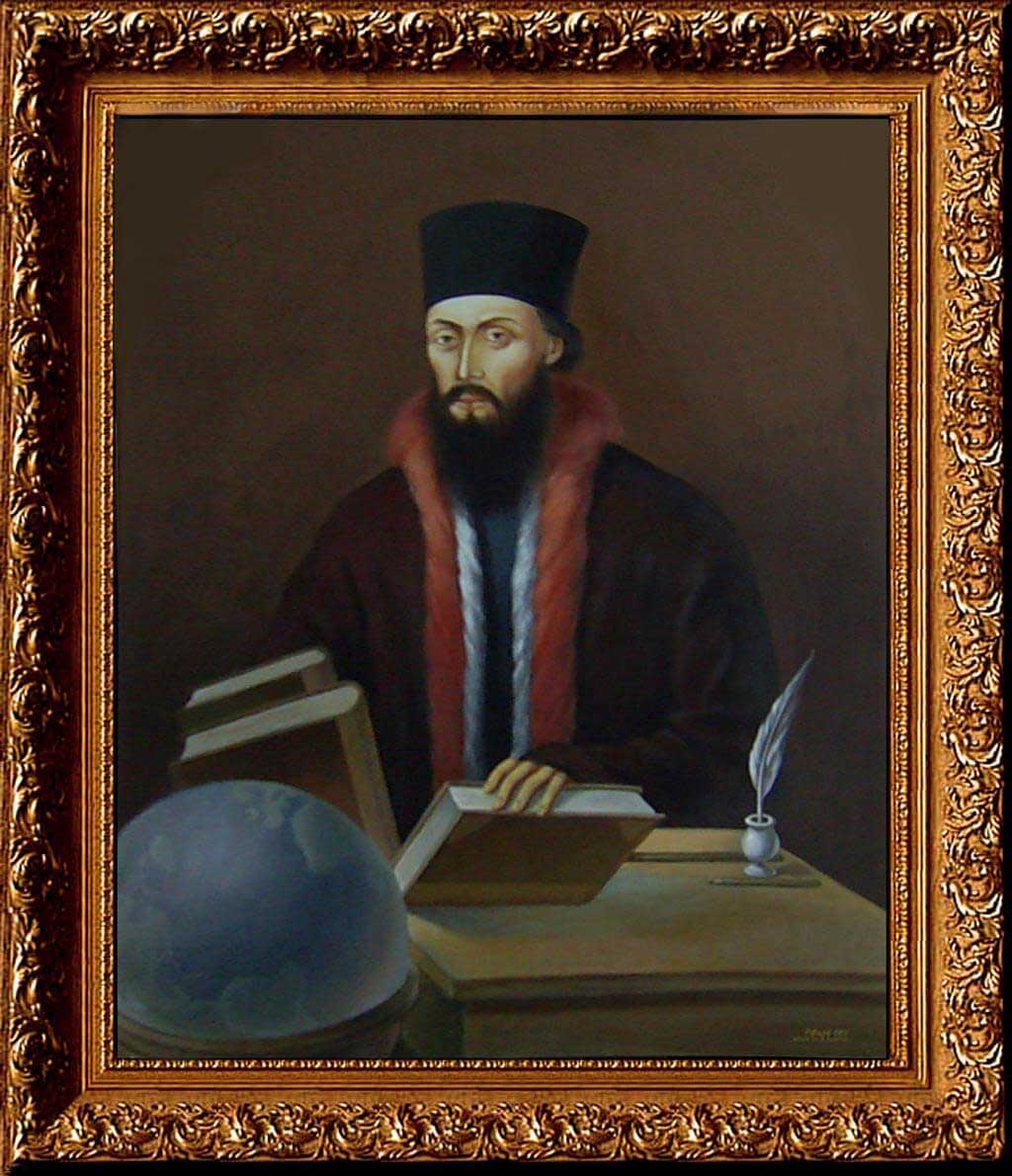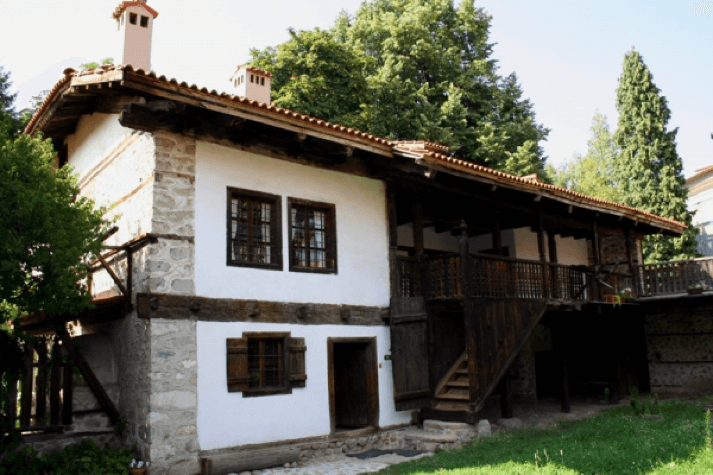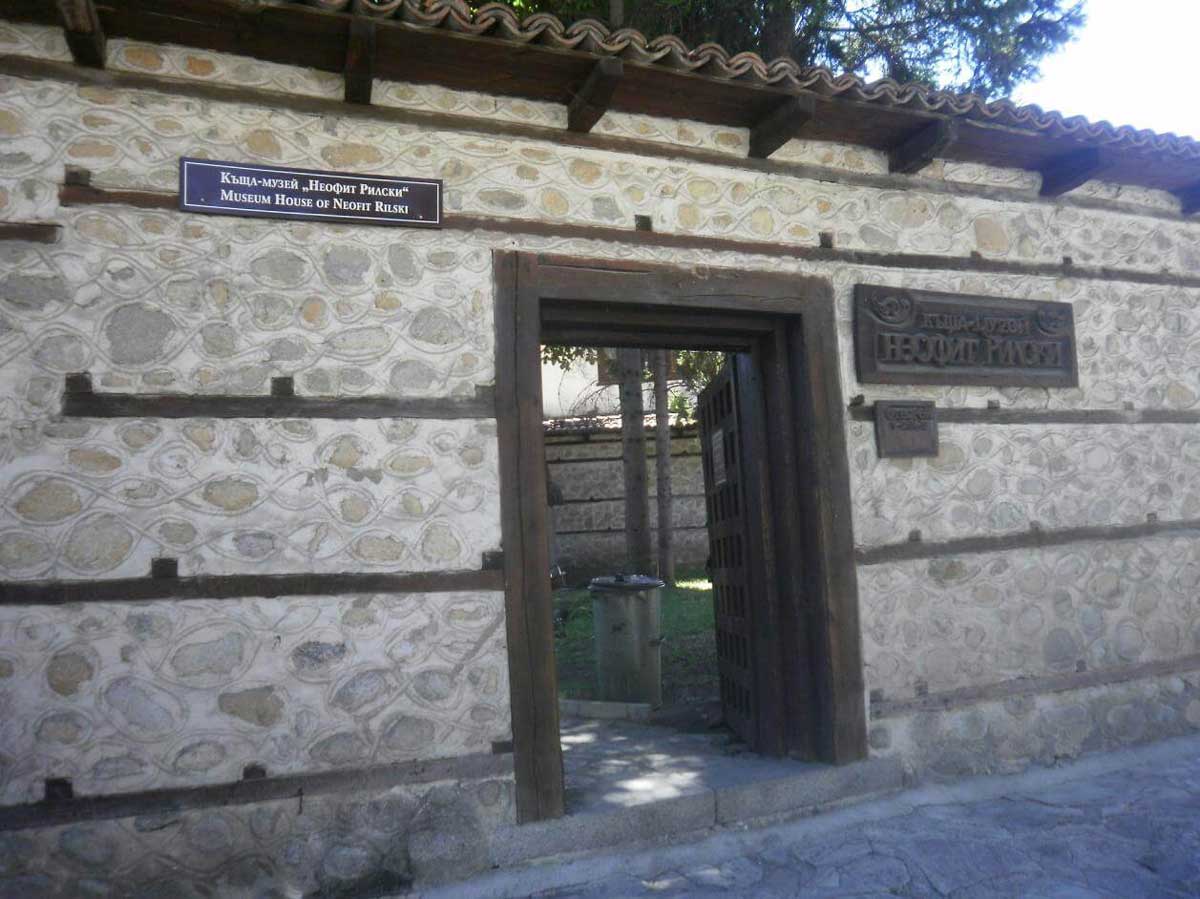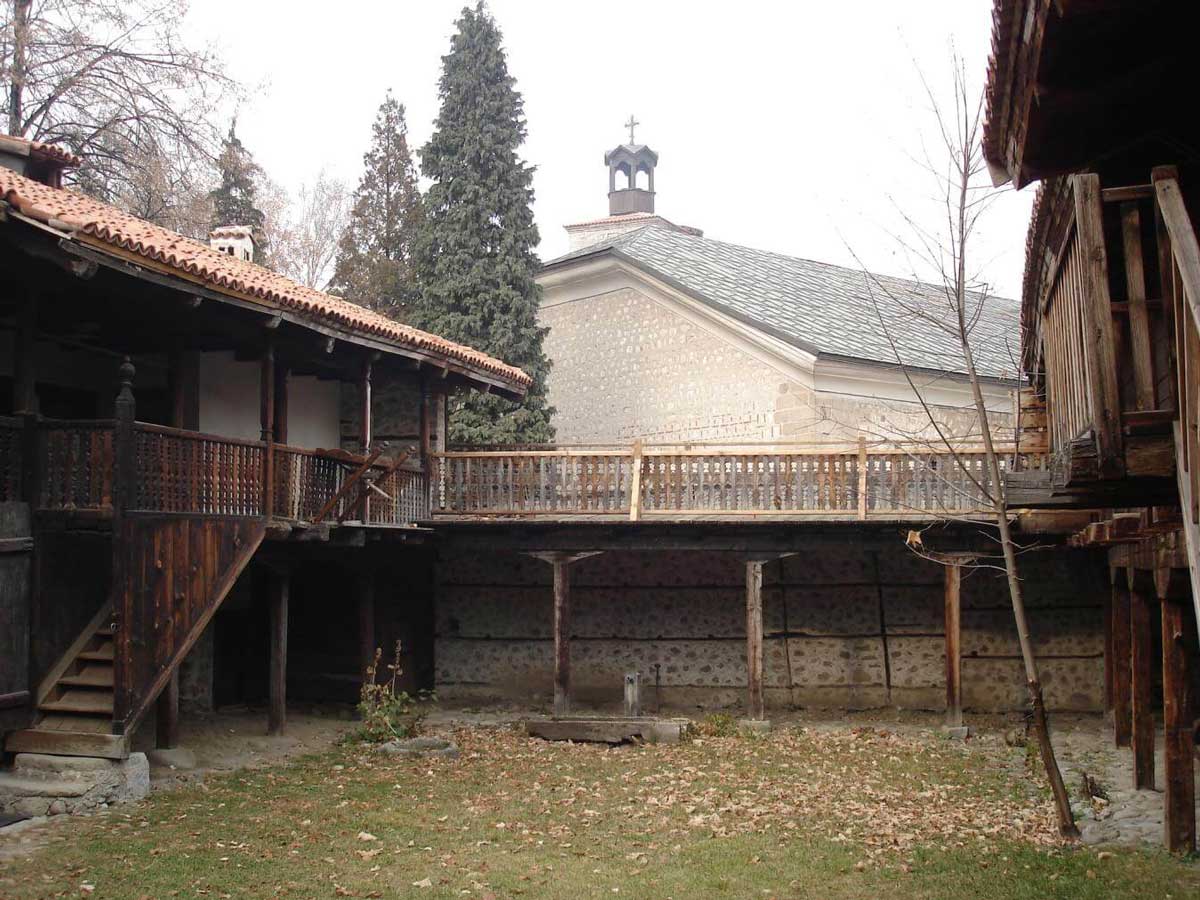The Benina House: the House-Museum of Neofit Rilski in Bansko
If you are drawn to Slavic and Bulgarian history, it will be interesting for you to get to know the historical side of Bansko. The Bansko Mountain Resort can really offer a lot when it comes to Bulgarian historical and architectural sites.
There are more than 120 cultural monuments in Bansko, and one of them is the house-museum Neofit Rilski.
Also known as the Benina house, the Neofit Rilski museum is a place for everyone to learn more about the life and work of a prominent Bulgarian monk, teacher, and artist. Moreover – it’s among the easiest and most intriguing ways to understand how the Bulgarians in the Bansko region used to live by the end of the Ottoman rule.
In its role as a cultural heritage with national status, the birthplace and house museum of Neofit Rilski enjoy a year-round interest from Bulgarians and foreigners. Below, you can see our full guide for experiencing the Neofit Rilski house museum while enjoying your vacation in Bansko.
Who is Neofit Rilski?
The real name of Neofit Rilski is Nikola Poppetrov Benin – a famous Bulgarian Revival writer and enlightener with diverse interests.
He was a monk, a teacher, an artist, an architect, a musician, and a poet, which makes him one of the patriarchs of the Bulgarian enlightenment. Neofit Rilski is also the founder of the Bulgarian secular education and the first Bulgarian encyclopedist.
Nikola Poppetrov Benin was born in 1793 as a descendant of merchants and diplomats and died in 1811 as what Konstantin Irechek described as the “patriarch of the Bulgarian teachers and scholars“.
The famous writer of the Bulgarian national revival studied icon painting with the founder of the Bansko Art School, Toma Vishanov-Molera. He demonstrated his icon painting skills at the Rila Monastery, where he later became a monk and also an abbot of the monastery.
Throughout his life, Neofit Rilski has been committed to progress. Except for the driving force of the Bulgarian secular education, he was also the made the translator of the first popular edition of the New Testament in our language.
Among everything else, history will also remember Neophyte Rilski as the author of the first Bulgarian grammar book. In 1835, he published Bolgarska gramatika, or Bulgarian grammar – the first book that described the rules of the modern Bulgarian language.
Nowadays, Neofit Rilski’s birthplace in Bansko was transformed into Neofit Rilski House-Museum, also known as Benina House. He lived there until his death in 1811, when his final words were:
“I am not afraid of death itself, but I am afraid that there will still be many unfinished things that are necessary for the enlightenment of the Bulgarians”.
What Is the Story of the Home of the First Bulgarian Encyclopedist, and What Can You See Inside?
The house-museum Neofit Rilski has a rich history. It was built in the XVIII century in the center of Bansko by the old and well-known merchant family of Benini, hence the name Benina house.
It is a typical representative of the traditional style of Bansko architecture from the 18th century until the beginning of the 19th century. In the long list of Bansko houses to see during your stay, this easily stands out with spirit and character.
The Neofit Rilski House Museum is located in a large courtyard, surrounded by massive stone walls and a massive wooden gate. When you look at the museum house, you can immediately notice the characteristic architecture of Bansko from the end of the 18th century during the period 1730-1750.
The structure of the house is a typical example of what the fortified houses in Bansko looked like, resembling the style of the Razlog-Chepino house-fortresses.
Neofit Rilski was born there in 1793, and the Neofit Rilski house-museum officially opened its doors in May 1981 for the 100th anniversary of his death. Until its opening as a permanent museum exposition, the house was managed by distant relatives of Neofit Rilski.
The objects exhibited in it are in chronological order and give information about Neofit Rilski’s long-standing and diverse work for the benefit of the people.
Later on, the museum of Neofit Rilski was declared an architectural construction monument and a cultural monument of national importance. It acquired the status of an architectural and building monument in a news section of issue 87 of the State Gazette in 1967. As of today, the House Museum of Neofit Rilski is also a part of the 100 national tourist sites of Bulgaria.
Today, the museum of the first Bulgarian grammar book writer will offer a rich and rewarding experience for tourists. There, you can see a permanent exhibition arranged in chronological form, showing materials that reveal the long-standing activity of Neofit Rilski.
The museum offers documentary and ethnographic expositions, consisting mainly of writing material, pictures, and letters. More than 400 artifacts and documentary materials related to the great work of Neofit are presented.
The most special of all exhibits include:
- The first Bulgarian grammar book from 1835;
- Excerpts from the unfinished Greek-Bulgarian dictionary;
- Books from Neofit Rilski’s personal library;
- A transcript of Slavonic-Bulgarian History;
- Tables for mutual learning from the monastery school, etc.
The seal of Neofit Rilski from the time when he was an abbot of the Rila Monastery was also preserved, along with some artifacts from his art school and cell school periods. All of them are arranged in chronological order, so you don’t have to be too aware of Bulgarian history to put the pieces of the puzzle together.
All you need to do is take your time and explore this site of national importance from the first floor to the last.
What Are the Style and Structure of House-Museum Neofit Rilski?
The home of Neofit Rilski suffered a series of restorations throughout the years. In 1810, the house was burnt down. After that, it was restored, and new rooms and farming premises were built. Later on, in 1981, it was already ready for visits.
Luckily for us, the authentic appearance of the Neofit Rilski house is very well preserved. Similarly to other old houses in the area, only cosmetic repairs have been carried out on the original structure.
Except for that, multiple cupboards and shelves, a fireplace, a bed, and open-air decorative trimmer joists are also preserved.
The Basic Structure
The house museum can be defined as a miniature fortress because it has many tunnels and hidden exits, with a total of four outlets. Its four outer walls are surrounded by an additional circle of walls between them, and there is a hiding place leading to the exits of the house outside.
On its outer side, there is an additional line of walls designed to provide a hiding place and an escape route for the family living in the house.
The native home of Neofit Rilski is on two floors, with a ground floor and a residential floor. In its western part, there is the fortified main part, typical of the Bansko house. It is located in a closed courtyard with a massive gate with entrances for people and for a team of horses opposite the staircase of the house museum.
The reinforced main part and the surrounding walls are stone-built, and the partitions are frame-built – filled with a mass clay solution. Its floors are thick clay-isolated planks, also typical for authentic Bansko architecture.
The Ground Floor and the Hiding Place
Bansko houses are characterized as having two floors, and the doors have a low upper threshold so that the person passing through them could bow to the master of the house and pay tribute to them.
This style of doors originated during Ottoman rule, prompting a Turk who entered the home of a local Bulgarian to bow down his head.
The house museum has a ground floor, which houses the following rooms:
• A two-part hiding place for the whole family – a small room with a furnace;
• A living room;
• A kneading room called a mesilnik or brashnenik;
• Farming and service rooms;
• A kitchen with a double furnace which cannot be found in the other old houses of this period;
• A storage room for winter and food supplies;
• And a small window.
Close to the kitchen and the storage room is the so-called podnik – a room where the animals used to live.
This animal room is now covered with frescoes representing the Neofit Rilski family tree. Todor Tsonev is the man who drew the frescoes. The image of Neophyte Rilski as Little Nikola (Nikola is the secular name of Neofit) can be seen in the middle of the fresco.
On his both sides are painted his parents Katerina and Peter, who was a priest and monastery teacher. Neofit had one brother and two sisters.
There is a double iron door to enter the hiding place itself. In the past, it was also connected to the fortified part of the residential floor and the one above it. The hiding place was accessible through a movable wooden staircase, hidden beneath the columns that supported the first floor.
The Second Floor
On the second floor, there are a few different rooms.
These are:
- An anteroom;
- An adapted monastery school;
- Kashchi (a large bedroom that operated as a living room, a kitchen, a dining room, and a bedroom);
- A reception room of the priest Peter;
- A female room used for childbirth;
- And a living room.
The outside terrace of the house is linked to the former farm buildings. House and farm buildings were linked through a large balcony that led to the agricultural part of the house.
These former farm buildings are currently hosting a documentary exposition. It contains materials about the rich patriotic enlightenment and folk-life activities of the great Bulgarian grammar book writer with his encyclopedic activities and interests.
How to Find the Benina House in Bansko?
After it was turned into a museum in 1981 on the occasion of the 100th anniversary of the death of Neofit Rilski, this house has attracted thousands of tourists.
The museum dedicated to the famous Bulgarian writer is situated in the historical center of Bansko. You can see it just opposite the impressive Holy Trinity Church with its 30-meter clock tower and bell tower.
The address of the house is ul. Pirin 17, and you can easily find it by browsing directions to the St.Trinity church. Its working hours are 9:00 AM – 12:00 PM, 1:00 PM – 5:30 PM, and it is normally closed on Tuesdays. Every first Monday of the month, entry to the museum is free of charge.
After you take a few deep breaths on the beautiful outside terrace, you can keep exploring the area and its numerous old houses. The nearby Velyanova House was also declared a national monument of culture by the state gazette, and the Rila monastery itself is located just about 100 km away from Bansko.




